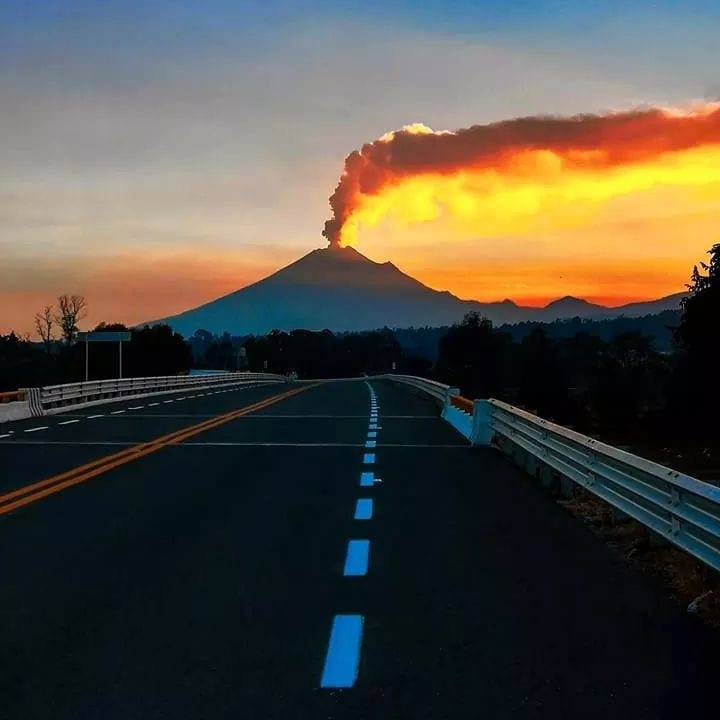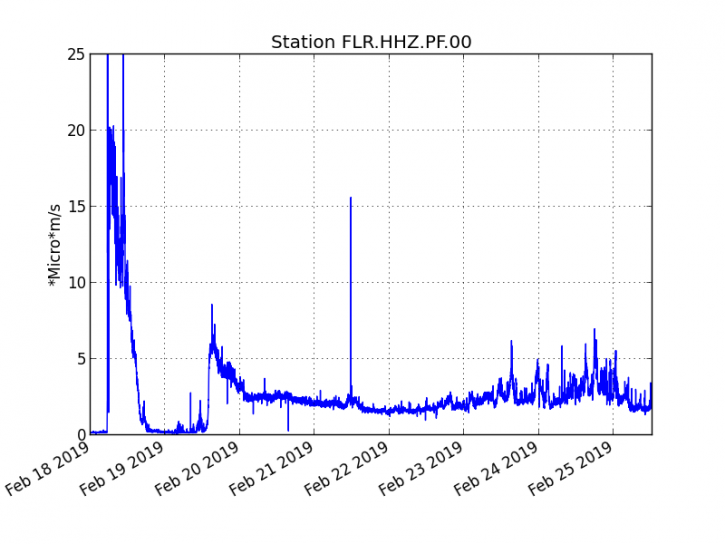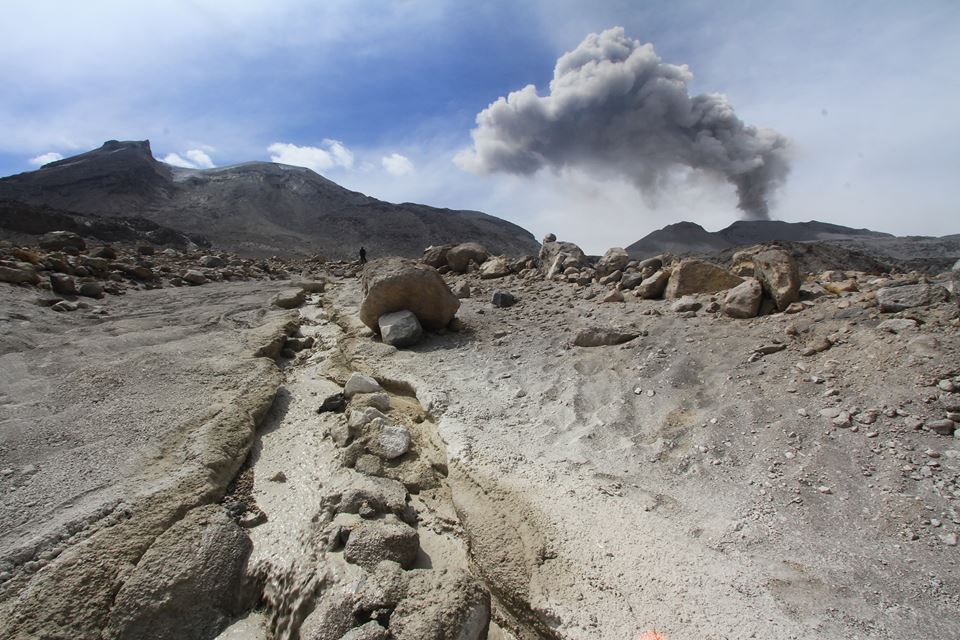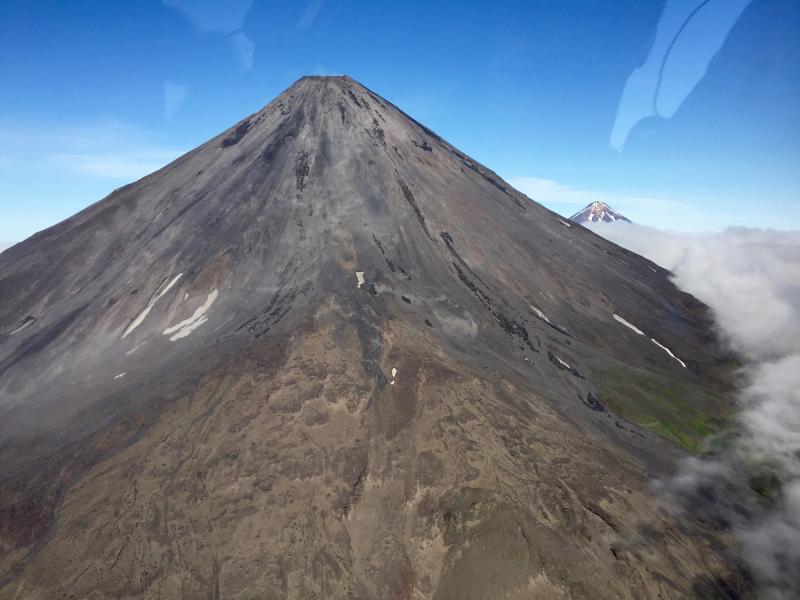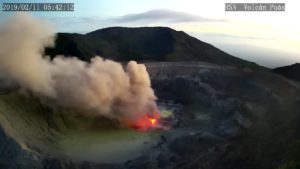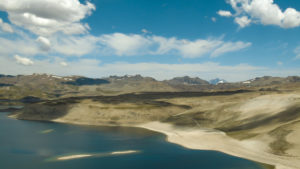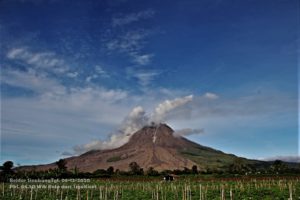February 26 , 2019.
La Réunion , Piton de la Fournaise :
Activity Bulletin from Monday, February 25, 2019 to 17:00 (local time).
The eruptive activity that resumed on February 19, 2019 at Piton de la Fournaise around 7:10 pm local time continues. Despite some fluctuations, the intensity of the eruptive tremor (indicator of the intensity of the eruption) remains relatively constant (Figure 1).
Figure 1: Evolution of RSAM (indicator of volcanic tremor and intensity of eruption) between 09h48 (05h48 UTC) on February 18th and 16h30 (12h30 UTC) on February 25th on the seismic station of FLR. (© OVPF / IPGP) (OVPF / IPGP)
– Over the last 36 hours, 11 superficial superficial volcano-tectonic earthquakes (above sea level) have been recorded.
– After a deflation of the building related to the transfer of magma that occurred on 18/02/2019, the deformations of the summit zone do not show any particular signals.
– The CO2 concentrations in the near-field soil (gîte du volcan area) remain high.
– Over the last 36 hours, surface flows estimated from satellite data, via the HOTVOLC platform (OPGC – University of Auvergne), fluctuated between <1 and 13 m3 / s.
Alert level: Alert 2-2
Source : OVPF
Photo : Rb et Mon ami pour Imazpress.
Peru , Sabancaya :
An average of 20 Explosions / day was recorded. The activity associated with fluid movement (long period type) continues to predominate. On the other hand, the earthquakes associated with the rise of the magma (hybrid types) remain very few and not very energetic.
The columns of gas and eruptive ash reached a maximum height of about 2,200 m above the crater, determined despite the low visibility in the area. The dispersion of these materials occurred within a radius of about 30 km, mainly to the southwest.
The GNSS SBSE station, which measures the deformation of the volcanic building, has not recorded any significant changes (the rate of inflation was minimal during this observation period).
Two thermal anomalies were recorded according to the MIROVA system, with values of 7 to 10 MW VRP (Radiated Volcano Energy).
In general, eruptive activity maintains moderate levels. No significant changes are expected in the coming days.
Source : IGP Peru
Photo : Ingemmet.
Cleveland , Alaska :
Current Volcano Alert Level: ADVISORY
Previous Volcano Alert Level: WATCH
Current Aviation Color Code: YELLOW
Previous Aviation Color Code: ORANGE
Issued: Monday, February 25, 2019, 11:24 AM AKST
Source: Alaska Volcano Observatory
Notice Number:
Location: N 52 deg 49 min W 169 deg 56 min
Elevation: 5676 ft (1730 m)
Area: Aleutians
Volcanic Activity Summary:
Satellite data from 22 February 2019 and regional seismic and infrasound data show no evidence of eruptive activity. Thus, AVO is lowering the Aviation Color Code to YELLOW and the Volcano Alert Level to ADVISORY.
The east flank of Mount Cleveland with the summit of Carlisle Volcano in the background.
Future explosions at Cleveland are likely. They occur without warning and typically produce relatively small volcanic ash clouds that dissipate within hours; however, more significant ash emissions are possible.
Recent Observations:
[Volcanic cloud height] None
[Other volcanic cloud information] n/a
[Lava flow/dome] no new lava efffusion
Remarks:
Cleveland volcano does not have any functioning equipment near the volcano, which restricts AVO’s ability to detect precursory unrest that may lead to an explosive eruption. Rapid detection of an ash-producing eruption may be possible using a combination of regional seismic, infrasound, lightning, and satellite data.
Source : AVO.
Photo : Lyons, John.
Mexico , Popocatepetl :
February 25th at 11:00 am (February 25th at 17:00 GMT)
In the last 24 hours, thanks to the monitoring systems of the Popocatépetl volcano, 33 exhalations have been identified, accompanied by water vapor, gas and ash that the winds have dispersed preferentially towards the North-East. In addition, 751 minutes of harmonic tremor and two explosions were recorded yesterday at 17:38 and 22:43. During the night, incandescence and a continuous emission of water vapor and volcanic gases were observed.
At the time of writing, the crater was not visible, but the amplitude of the seismic signal was reduced. In case of emissions, they are scattered in the direction East-North-East.
On February 18 and 19 of this year, two overflights were carried out on the Popocatépetl volcano with the support of the federal police to evaluate the recent activity of the volcano and to measure gas emissions. On the basis of the data and observations obtained, the formation of the number 82 dome in the crater of the Popocatepetl volcano was confirmed; its diameter is estimated at 200 meters
The recommendations for the population before this activity are:
Do not pay attention to rumors and trust information disseminated by the National Coordination of Civil Protection through its channels and official accounts.
The public is reminded that the Volcanic Alert light is maintained in Yellow Phase 2. The surveillance of the Popocatépetl volcano is carried out continuously 24 hours a day. Any change of activity will be reported as soon as possible.
CENAPRED urges NOT to approach the volcano and in particular the crater, because of the risk of falling ballistic fragments, and in case of heavy rains to stay away from gully bottoms due to the risk of landslides and mudslides mud.
The Popocatepetl Volcano Alert light is located at Amarillo Phase 2.
Source : Cenapred .
Photo : Marco Antonio Nuñez via Sabrina Munoz et Philip Evans.

